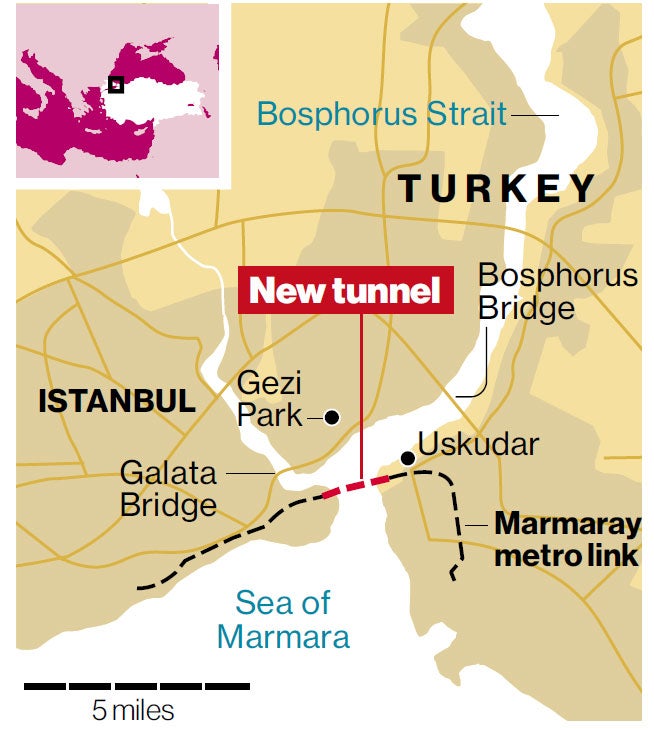Tunnel vision: the €3bn project to join Europe and Asia that has split Turkey
After long delays a 150-year plan to connect Istanbul’s twin coasts is finally ready - albeit with only three of its planned 37 stations. But could this unpopular project trigger further protests?
Your support helps us to tell the story
From reproductive rights to climate change to Big Tech, The Independent is on the ground when the story is developing. Whether it's investigating the financials of Elon Musk's pro-Trump PAC or producing our latest documentary, 'The A Word', which shines a light on the American women fighting for reproductive rights, we know how important it is to parse out the facts from the messaging.
At such a critical moment in US history, we need reporters on the ground. Your donation allows us to keep sending journalists to speak to both sides of the story.
The Independent is trusted by Americans across the entire political spectrum. And unlike many other quality news outlets, we choose not to lock Americans out of our reporting and analysis with paywalls. We believe quality journalism should be available to everyone, paid for by those who can afford it.
Your support makes all the difference.More than 150 years since it was first dreamed up by an Ottoman sultan, Turkey will on Tuesday unveil the world’s first sea tunnel linking two continents.
The tunnel, which has taken nine years to construct under the Bosphorus straits, is part of Istanbul’s metro service, and will connect the European and Asian sides of Turkey’s biggest city.
Known as the Marmaray metro link, it is slated to revolutionise the city, where public transport is limited and traffic jams are the stuff of legend.
But not all of Istanbul’s 15 million residents – or the rest of Turkey for that matter – are overjoyed at the inauguration of the new line. Some see it as an unnecessary and expensive prestige project for Turkish Prime Minister Recep Tayyip Erdogan, and it has fuelled anti-government sentiment that continues to bubble.
First suggested by Ottoman sultan Abdoul Medjid in 1860, it wasn’t until 2004 that Erdogan – then Mayor of Istanbul – gave the final go-ahead for the tunnel, as part of a series of lavish construction projects for the city including a third airport, a parallel canal and a third bridge. It was one such project which prompted widespread unrest in May and June, after Istanbul’s residents protested against plans to bulldoze part of Gezi Park to make way for a huge shopping centre. When police used water cannons and tear gas to clear the peaceful sit in, violent protests erupted across the country.
Nine years after Erdogan gave it the green light, the €3.4bn (£2.9bn) first stage of the Marmaray project is now set to open – four years behind schedule. Presenting something of a technical challenge, the 1.4km long undersea tunnel was constructed by lowering steel-lined pre-cast concrete sections into a trench excavated 60m down on the seabed of the Sea of Marmara, where they were then buried. A further 12.2km of on-land tunnels connect the three stations which make up the project’s first phase.

The delays, however, stemmed not from technical issues but from the discovery of 8,500 year-old archaeological remains at the site of the main metro terminus – discoveries that were not welcomed by Erdogan, who saw them as inconvenient hold-ups.
“First [they said] there was archaeological stuff, then it was clay pots, then this, then that. Is any of this stuff more important than people?” he said at the time of discovery, two years ago.
His somewhat cavalier attitude to his city’s history has drawn widespread criticism, not least because many believe the delays could have been avoided archaeologists been consulted ahead of time.
“There were long delays and there should be a report commissioned to establish just why this happened,” says Tayfun Kahraman, head of the Istanbul Chamber of Urban Planners.
The decision to hold a grand opening ceremony attended by Japanese Prime Minister Shinzo Abe (35 per cent of advance funding for the project came from Japan) and a host of other foreign dignitaries on Tuesday – the 90th anniversary of the Turkish Republic – has been greeted with cynicism by many. Though it is being touted as a project that the nation should be proud of, less than 20 per cent of the planned 76km Marmaray line and only three of the planned 37 stations will actually be operational.
“They were expecting the Olympics but that didn’t work so they are emphasising this project,” says Cengiz Candar, columnist on respected Turkish daily Taraf, pointing to Turkey’s failure to land the 2020 Games.
The decision to push ahead with the project, and a similar decision to build a third road bridge across the Bosphorus despite popular opposition, closely mirror that taken earlier this year to destroy Gezi Park. The uncompromising police tactics used in June against many of the hundreds of thousands who turned out onto Turkey’s streets have ensured subsequent protests have been far smaller. But that has not prevented the appearance of tens of thousands of posters calling for mass protests on both the city’s European and Asian sides to coincide with the opening.
Bosphorus: a brief history
Marking the meeting point of Europe and Asia, the Bosphorus has been a flashpoint between civilisations for thousands of years.
As far back as the Roman Empire, the strait’s strategic significance has been recognised – a factor which led the Roman emperor Constantine to found his new capital, Constantinople, on its banks in 330 AD.
A plan to connect the two continents was originally conceived by the Ottoman Empire Sultan Abdoul Medjid in 1860. But the project came to nothing because of the lack of technical expertise available.
Join our commenting forum
Join thought-provoking conversations, follow other Independent readers and see their replies
Comments